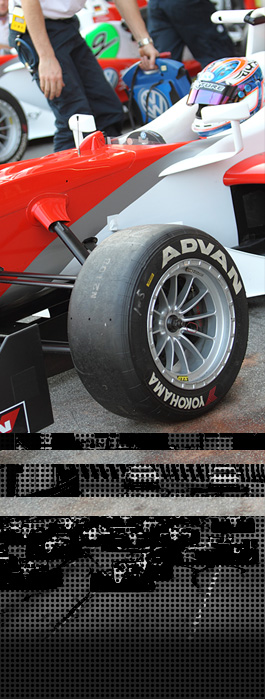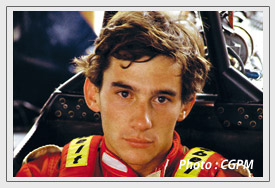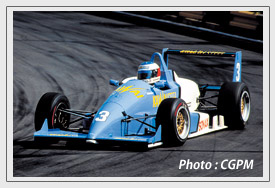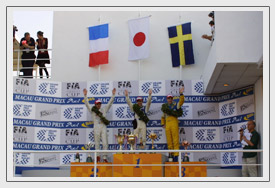 |
 |
 |
 |
 |
 |
 |
The inaugural Macau Grand Prix was held in 1954 and 15 drivers took part in that event, according to history books.
Looking back at the history of Macau, the area had been the Portuguese colony since 1887. Naturally, it became a center of commerce of trade between Asia and Europe and many Portuguese resided there. This meant the latest products of Western culture kept coming in to the colony and not a few wealthy people bought automobiles when they became commercially available. Then it was also natural that, as were the cases everywhere in the world, those early car owners began to compete on the speed of their machines with each other and soon they wanted an organized race meeting.
 The inaugural Macau Grand Prix was a four hour race on the original 3.9 mile Guia Circuit and Eduardo de Carvalho, driving a Triumph TR2, put his name on the first page of the official record book by his glorious victory. For the third meeting in 1956, the ten pit garages and the spectator stand with 300 people capacity were built. Two years later, the course layout of Guia Circuit was modified into its current form - 3.8 mile (6.115km) in length.
The Grand Prix made a great leap forward in the sixties. By adopting FIA's Sport Car and Grand Touring Car regulations, it had secured a slot on the Federation's International Sporting Calendar and was formally given international event status.
In 1962 and 1963, Arsenio Laurel won the Grand Prix with his Lotus 22 for two consecutive years and became the first driver ever to do so. But, sadly, he also became the first driver to be killed in a race accident in the event's history in 1967.
From late sixties to early seventies, the presence of Japanese cars and drivers has become more prominent. For example, Mitsubishi sent its own formula cars, named a Colt, to Macau for a couple of years and, in 1969, Sohei Kato drove it and finished the race in third. Nobuhide Tachi - the co-founder of Tom's - won the 1974 Guia race with his Toyota Celica and became the first Japanese Macau winner. He then repeated the victory next year and earned him the nickname Tiger of Macau. From 1974, the Grand Prix adopted Formula Pacific regulations - effectively Formula 2 at that time but with 1.6 liter engine - for the feature race and, with appearances of the top level guest drivers, the event became more and more attractive.
Thus, through its first quarter-century, Macau Grand Prix has established itself as one of the world class major motor sport events in Asia and earned recognition as a truly unique race meeting that combines the topnotch formula car and touring car races, as well as the Motorcycle Grand Prix, in one weekend. |
 |
 |
 |
The 30th Macau Grand Prix in 1983 marked a major turning point for the event's history. The organizers decided to adopt Formula 3 cars for the feature race and it was sanctioned by FIA as the F3 World Cup title race. At the same time, Yokohama Tire was officially designated as the sole supplier of control tires for the competitors. Since then, Yokohama has been providing the reliable "footgear" for the Macau F3 Grand Prix racers for 30 years.
 The race winner in this first year of F3 Grand Prix was none other than late Ayrton Senna who became the three time Formula One world champion later. Before winning Macau Grand Prix, the Brazilian had claimed the British F3 championship tile in the same year by scoring an unstoppable nine consecutive race wins. With these remarkable results under his belt, Senna launched his career as a Formula One driver in 1984.
John Nielsen didn't have an opportunity to get into Formula One after his Macau victory in 1984 but he became a much-in-demand sport car and touring car driver in professional level. The Dane's main achievement includes the overall first place in Le Mans 24 hour race in 1990 and the Japanese GT champion in 1996 (GT500 class). Mauricio Gugelmin won the Grand Prix in 1985 and moved up to F1 Grand Prix racing in 1988, while Martin Donelly's 1987 Macau victory led to a slot in Formula One two years later.
David Brabham was the last Macau winner in the eighties. The youngest of three sons of Jack Brabham had come to the ex-Portuguese settlement after claiming the British F3 championship title in 1989. Although his two stints in Formula One in 1990 and 1994 didn't last long in both times, the Australian was successful in sport car racing and won the Japanese GT championship in 1996, as a partner of Nielsen, and then, more recently, became the winner of Le Mans 24h in 2009. |
 |
 |
 |
In the early nineties, Macau Grand Prix had become widely known as the race of F3 champions from around the world and was one of the essential steppingstones to make their way into Formula One for the drivers. Winning at Macau was now considered as a gateway to a bright future and, therefore, many young aspiring race drivers have desperately tried to grab it.
 Michael Schumacher - nicknamed as Kaiser, meaning the emperor in German, later in his career - won Macau Grand Prix in 1990. The German F3 champion that year beat Mika Hakkinen who was the British F3 champion and the hot favorite at Macau. Schumacher also claimed the victory in Inter F3 League race at Fuji Speedway in the week after and then made his Formula One debut at mid-season in 1991.
The winner in 1991 was David Coulthard. While he had to settle for the runner-up position in the British F3 Championship that year, the Scot demonstrated his undoubted talent by winning at Macau and, after two seasons in the International F3000 series, he was picked up by Williams Formula One team.
During the mid-nineties, a few more Macau winners reached to Formula One. The younger brother of Michael, Ralf Schumacher, triumphed in the Grand Prix in 1995 and they became the first brothers to claim a win each in Macau. The runner-up of the German F3 championship that year then built his career in Japan and competed in Formula Nippon series and the Japanese GT championship until he secured a slot in Formula One in 1997. Ralph Firman, the winner in 1996, also headed to Japan and stayed there for several seasons to drive in Formula Nippon and the GT championship series in the country, before having one season in F1 with Jordan in 2003.
But Formula One wasn't the only destination for the Macau winners. For example, the list of past winners includes the names like Rickard Rydell (1992) and Jorg Muller (1993) that were familiar for the circle of WTCC - the World Touring Car Championship which is another feature race category in Macau these years. Muller was one of the leading BMW factory drivers in the early years of the championship and Rydell also shone out in the same series, driving for Chevrolet and SEAT. |
 |
 |
 |
In 2000, Andre Couto became the first Macau resident in the F3 era who got on the highest place of the Macau Grand Prix podium. Since his first appearance in 1995, Couto finally realized his long-cherished wish to win the Grand Prix and got massive applause from the local spectators.
 The next year, the national anthem of Japan was played for the first time at the F3 Grand Prix podium in celebration of Takuma Sato's victory. He won the British F3 championship that year in his second attempt, as the first Japanese driver to claim it, and fought at Macau to add glory to his best F3 season.
The results led to a seat in Formula One in 2002 and Sato stayed in the top formula for six and a half seasons. Being widely recognized as an international race driver, he is still active in the Indy Car series in U.S. since 2010.
The other firsts in recent years includes Edoardo Mortara's two consecutive victories - in 2009 and 2010 - that had never been achieved in the F3 era before. The Italian later became a leading driver in the DTM (Deutsche Tourenwagen Masters) series, as is the case with Oliver Jarvis, the Macau winner in 2007. Thus the Macau Grand Prix winners are always in demand not only in Formula One but in other wide variety of professional motor racing fields. |
|
 |
 |
 |
|
|
 |
|